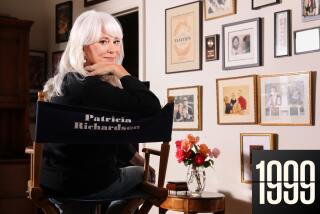L.A. without the NEA: Lula Washington’s aim is to lift up lives through dance
Lula Washington is not one to get discouraged.
In the 1970s she was denied admission to study dance at UCLA based on her age, 22, which the university deemed too advanced for the program. Washington appealed the decision to the dean in a heartfelt letter and gained admittance after all, said her husband, Erwin Washington.
Lula, who was married and had a small child at the time, went on to found the university’s Black Dance Assn. This proved a harbinger of her life’s work: the founding, in 1980, of the nonprofit Lula Washington Dance Theatre. The Baldwin Hills/Crenshaw company’s mission is to provide a creative outlet for minority dancers in Los Angeles, and it has performed in more than 150 cities in the U.S. as well as in Germany, Spain, Kosovo, Israel, China, Russia and Brazil.
To me the arts can prevent war, the arts can save a nation, and they can save young people.
— Lula Washington
In 1983 Washington established a dance school to provide low-cost and free dance lessons to kids in low-income neighborhoods. More than 45,000 inner-city children have attended the school.
“To me the arts can prevent war, the arts can save a nation, and they can save young people,” Lula Washington said after the Trump administration released its budget blueprint, which recommended the elimination of the National Endowment for the Arts.
Lula Washington Dance Theatre has received 11 grants from the NEA totaling $175,000 since 1998.
“For 20 years the NEA has provided some type of support for our programs,” said Washington, who conceived choreography for “Avatar” and appeared in the films “Sgt. Pepper’s Lonely Hearts Club Band” and “Funny Lady,” among others.
This year a $30,000 NEA grant will help to stage the 2018 International Assn. of Blacks in Dance Conference, which will take place at the Aratani Theatre in downtown L.A. The five-day event in January is expected to draw 500 to 600 people from the U.S. and abroad, said Erwin Washington, who co-founded the company with Lula. The conference offers classes for young dancers, auditions for colleges and professional dance companies, and the chance to apply for salaried jobs in the dance world.
“It’s extremely impactful on the lives of young people,” Erwin Washington said. “Especially inner-city young people.”
Half of the NEA grant money will go toward the theater rental and the hiring of theater staff including lighting and sound crew, ushers and box office workers. It will also pay for visiting dance teachers to lead master classes. The remaining $15,000 will pay for new choreography, in this case that of prominent African American dancer Chuck Davis, who created the DanceAfrica festival in 1977.
“He’s a legend, but not many companies do his work,” Erwin said, adding that if the 80-year-old Davis is not able to travel, the NEA funds will help to pay for company members to fly to him in North Carolina to rehearse.
Sustaining and honoring the choreography of African American artists, including Ronald K. Brown, Donald Byrd, Rennie Harris and Katherine Dunham, is a mandate of Lula Washington Dance Theatre.
“We try to preserve their work after they no longer have companies, or in some cases, after they’re no longer here,” Erwin said.
In 2004 the company received a $10,000 NEA grant to support a revival of works by African American modern-dance great Donald McKayle at the Luckman Fine Arts Complex at Cal State L.A.; in 2009 it received $15,000 to commission a ballet by former Alvin Ailey American Dance Theater member Christopher Huggins at the Cerritos Center for the Performing Arts.
“The elimination of the NEA will be a blemish on America,” Lula Washington said. “If you don’t value the arts, you don’t value humanity.”
“L.A. Without the NEA” is a daily series looking at a different community group, how its NEA funds were spent, what artistic or public good did or didn’t result and what the cultural landscape would look like if that program were to disappear. Look for more installments to follow at latimes.com/LAwithouttheNEA.
ALSO:
How would the death of the NEA affect your community?
L.A. without the NEA: Theatre of Hearts
More to Read
The biggest entertainment stories
Get our big stories about Hollywood, film, television, music, arts, culture and more right in your inbox as soon as they publish.
You may occasionally receive promotional content from the Los Angeles Times.











